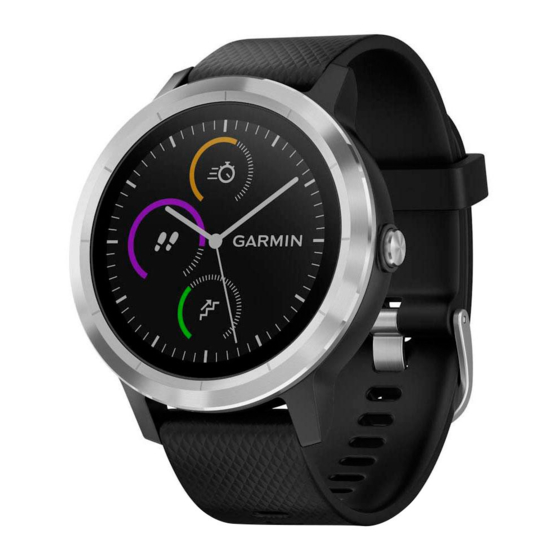
Garmin Vivoactive 3 Faq
Hide thumbs
Also See for Vivoactive 3:
- User manual ,
- Owner's manual (28 pages) ,
- Troubleshooting manual (7 pages)
Advertisement
Quick Links
My Garmin Device Is Paired but Not
Connecting to Sync Data to My Garmin
Connect Account.
If data from your Garmin device has stopped syncing to your Garmin Connect account, There
are some troubleshooting steps that you can take which should resolve your issue.
Troubleshooting Steps:
NOTE: Make sure that your Garmin device is within Bluetooth range of your smartphone and
that the Bluetooth setting on your device is not turned off. Either of these factors will result in
your Garmin device not connecting to sync with the Garmin Connect App on your smartphone.
Try each step followed by checking to see if the problem is resolved:
1. Close the Garmin Connect App. Then reopen it.
o
Apple instructions
o
Android Instructions
2. Power the Garmin device off and then power it back on
o
Rechargeable devices without a power button: Plug your device into a USB
power source using the charging cable. This is the equivalent of a restart.
o
vivofit devices: skip this step since you cannot power cycle your device
3. Power down the smartphone then power it back on
4. Remove then add the Garmin device from the Garmin Connect App
o
Instructions to do this can be found here:
App
FAQ
Removing and Adding a Device in the Garmin Connect
Advertisement

Summary of Contents for Garmin Vivoactive 3
- Page 1 My Garmin Device Is Paired but Not Connecting to Sync Data to My Garmin Connect Account. If data from your Garmin device has stopped syncing to your Garmin Connect account, There are some troubleshooting steps that you can take which should resolve your issue. Troubleshooting Steps: NOTE: Make sure that your Garmin device is within Bluetooth range of your smartphone and that the Bluetooth setting on your device is not turned off.
- Page 2 The Garmin Connect App is Not Finding my Garmin Device During the Pairing Process If you are attempting to add your Garmin device to the Garmin Connect App and the app is not finding your device, review the following common solutions that may solve your problem.
- Page 3 My Garmin Fitness Device Is Not Receiving Smart Notifications from My Phone In order to receive smart notifications on your Garmin device, it must be paired to your phone through the Garmin Connect app. If your device is paired and you are not seeing notifications, check the following which will resolve most issues: 1.
- Page 4 5. Enable access to notifications for Connect Controlling What Android Smart Notifications Display on a Garmin Device Managing which notifications from an Android phone that come across to a Garmin device can be controlled from the settings within the Garmin Connect app. To manage Smart Notifications: 1.
- Page 5 Improving the Accuracy of the Optical Heart Rate Sensor The optical heart rate sensor on your Garmin watch uses light to penetrate your skin and estimate your heart rate. This allows you to get heart rate information without the need for an additional sensor such as a heart rate strap.
- Page 6 When you start an activity with your Garmin Optical Heart Rate device, the optical heart rate monitor provides feedback more frequently as the optical sensor is on all of the time and is trying to measure heart rate on a continuous basis during a given activity period. The intent is to provide the user with a more frequent and accurate heart rate reading during a given activity.
- Page 7 Why does this happen? In some cases there isn't much blood in the tissue on the back of the wrist. This issue is common when it is cold outside or early in a workout before your blood really starts pumping. How can I prevent this from occurring? When you plan to workout, warm up a bit before starting the activity.
- Page 8 Skin Tone and Tattoos Can Affect Heart Rate Accuracy Skin tone has an effect as the melanin in the skin absorbs some of the light. Garmin designs our watches to work on all skin tones.
- Page 9 For higher Fitzpatrick classifications, more melanin is present in the skin. The sensor may have to work harder to find pulse which can require slightly more battery power What about tattoos? Tattoos absorb much of the light from the optical heart rate sensor which can cause major problems with accurately detecting heart rate.














